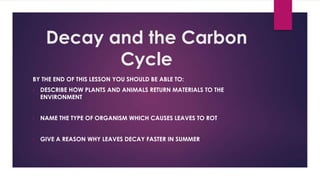Decay and the carbon cycle
- 1. Decay and the Carbon Cycle BY THE END OF THIS LESSON YOU SHOULD BE ABLE TO: ŌĆó DESCRIBE HOW PLANTS AND ANIMALS RETURN MATERIALS TO THE ENVIRONMENT ŌĆó NAME THE TYPE OF ORGANISM WHICH CAUSES LEAVES TO ROT ŌĆó GIVE A REASON WHY LEAVES DECAY FASTER IN SUMMER
- 2. What would happen if nothing ever decomposed or rotted?
- 3. What causes things to decompose or rot? ’üĄ Rabbit decomposing pic1. ’üĄ Rotting ŌĆö Science@home
- 4. Biodegradable v non biodegrable BIODEGRADABLE ’üĄ Capable of decomposing ’üĄ Capable of being broken down by bacteria and other microorganisms Non biodegradable ’üĄ Cannot be broken down by biological means
- 5. Investigation into factors affecting decay
- 6. What affects the rate of decay? TEMPERATURE High temperatures prevent decay, low temperatures slow decay High temperatures destroy enzymes and proteins, killing Temperature the organisms responsible for decay. Low temperatures slow the rate of reaction of enzymes and will prevent growth and reproduction.
- 7. What affects the rate of decay? OXYGEN Lack of oxygen will slow or prevent most forms of decay Oxygen is needed for Temperature respiration by organisms. Some bacteria can survive without oxygen, such as those used in biogas generators.
- 8. What affects the rate of decay? WATER Lack of water will slow or prevent decay Temperature ’üĄ Water is needed for transport and to support reactions inside organisms. Decay organisms need water to digest their food.
- 9. How can we prevent or slow down decomposistion? ’üĄ Fridges and Freezers - keeping things cold ’üĄ Keeping air out is important ŌĆō ’üĄ Drying things ŌĆō germs and mould are just like us, they need water to live. ’üĄ Smoking, salting and pickling were old ways of preserving as well, these all work by reacting with the chemicals in fresh food. Pickling uses lots of vinegar, which is an acid. Sugar can be used to preserve sweet things too by helping to dry them out, sugar sucks in any water around and stops it getting to the food. You can even put a sugar cube in a container with your cheese to stop it going mouldy. ’üĄ Cooking changes the chemicals in food too, which stops them reacting. This is why canning usually involves cooking, and cooked food lasts better than fresh food.
- 10. How is decay useful to plants? ’üĄ The molecules released during decay are absorbed by the bacteria, fungi and also back into the soil from where plants can draw them up through their roots. ’üĄ Bacteria in the soil change certain nitrogen compounds into ammonium compounds that are necessary for plant growth. ’üĄ Other decomposers break down dead plants and animals into simple chemicals. For example, coal and petroleum are formed from plants that became buried in swamps and decayed. ’üĄ The molecules released by this decay process include the most important elements carbon and nitrogen which have their own environmental cycles. ’üĄ ’üĄ Decomposition : Twig
- 11. How can kitchen and garden waste be recycled? ’üĄ There are five necessary conditions or factors for good decomposition: ’üĄ Organic material: plant or animal material to decay ’üĄ Water: the right amount of moisture ’üĄ Oxygen: air must be able to get to the material ’üĄ Warmth: the temperature cannot be too hot or too cold ’üĄ Decomposers: bacteria or fungi are needed to do the job ’üĄ You would not get decomposition if one of these was missing.
- 13. Space the final frontier ’üĄ Gravity - Official Main Trailer [2K HD] - YouTube
- 14. If an astronaut were to die in space would their body decompose? ’üĄ If you were in a protective space suit or capsule, it probably would decompose. ’üĄ If you were in open space, it would freeze dry. The extreme cold would freeze your body and the vacuum pressure would remove all the moisture from your body. Your body would be preserved indefinitely.












![Space the final frontier
’üĄ
Gravity - Official Main Trailer [2K HD] - YouTube](https://image.slidesharecdn.com/decay-20and-20the-20carbon-20cycle-140310015747-phpapp02/85/Decay-and-the-carbon-cycle-13-320.jpg)
